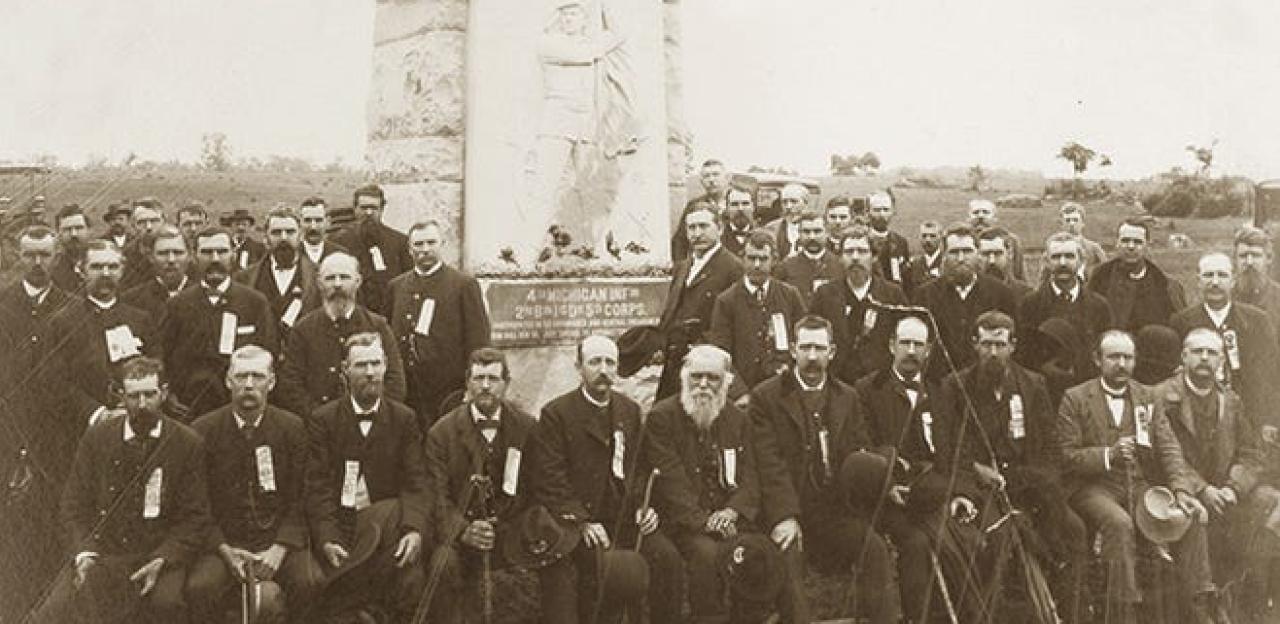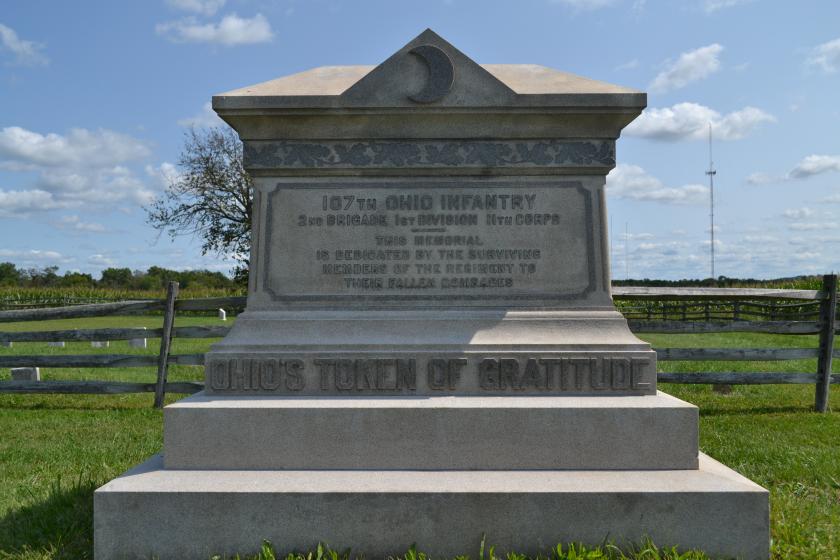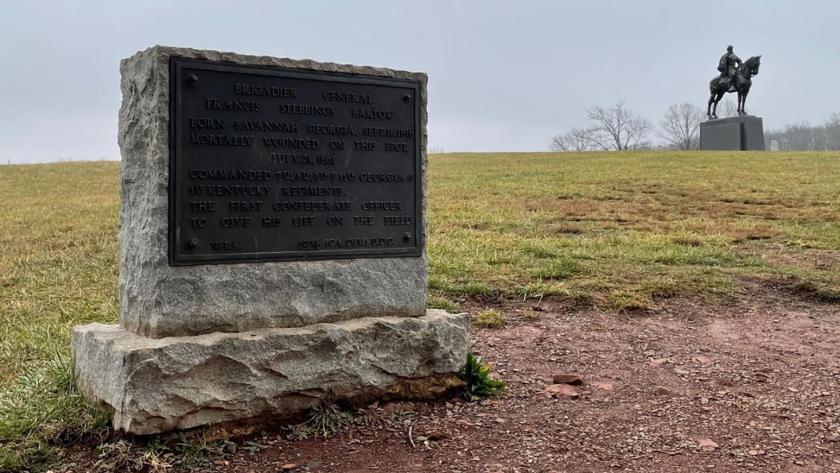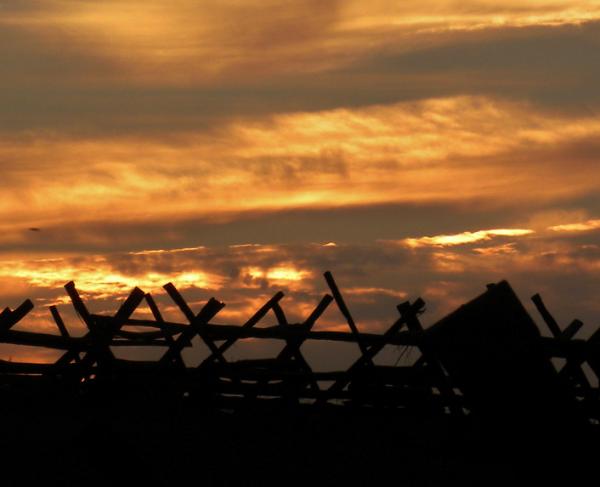Civil War Veterans and Their Monuments

On September 14, 1887, 40 survivors of the 107th Ohio Volunteer Infantry gathered atop Blocher’s Knoll, the deadly perch they attempted to defend on the first afternoon of the Battle of Gettysburg. Bedecked with tasseled ribbons and bronze medals, the aging veterans returned to dedicate the slab of Westerly blue granite that Boston stoneworkers shaped into a regimental monument. A quarter-century before, packed into the tip of a sharp salient on this forlorn rise, the Buckeyes had suffered horrific losses. Defiant knots of men continued to fight as they fell back — first through the campus of the old Adams County Alms House, and then through the borough’s confused streets. Fewer than 200 formed up that evening behind a low, stone fence atop East Cemetery Hill. There, the next evening, the veterans realized a redemption of sorts when they captured the colors of the 8th Louisiana, turned back one of the most feared rebel brigades, and, in a hand-to-hand fight, defended the anchor of the federal line. Gettysburg was a tale of two extremes for the 107th Ohio.
The Buckeyes made a most revealing choice when they opted to plant their regimental monument not at the scene of their greatest triumph, but instead at the scene of their greatest tragedy. Their decision betrays much about what battlefield monuments meant to veterans, and how Civil War survivors preferred to remember their service. Hardly exercises in vainglory or self-promotion, stone plinths and granite slabs paid tribute to the dead and testified to the participation of citizen-soldiers in an unprecedented war. Monuments recalled key episodes in the life of a regiment; they invested ordinary ridge lines, wheat fields, and wood lots with a transcendent significance. Monuments narrated the history of battles and campaigns; their imagery and inscriptions, together with the speeches veterans delivered at their dedication ceremonies, reflected on the Civil War’s cause and consequences.
In their design, concept, and construction material, monuments expressed meaningful connections between the home front and the battle front. The 20th Massachusetts Volunteer Infantry, for instance, marked the position where it repulsed Pickett’s Charge by prying a Puddingstone boulder from the earth near Roxbury; the stone was shipped to Gettysburg and mounted on a wide pedestal.
Keynoted by Maj. Augustus Vignos, the poignant dedication ceremony on Blocher’s Knoll was the culmination of a multi-year, veteran-driven effort to embellish the war’s bloodiest field with tributes to Buckeye soldiers. In 1885, Ohio’s legislature appropriated funds to “purchase land upon which to erect a monument” to its Gettysburg dead. On July 4, at the invitation of the state’s adjutant general, representatives of the Ohio units that participated in the battle — 13 infantry regiments, four artillery batteries, and two companies of cavalry — met in the chambers of the state legislature in Columbus to discuss the bill. The veteran assembly adopted a resolution expressing their “desire” to see a “proper designation of all the localities where Ohio soldiers fought” during the battle. “Very many beautiful tablets have been erected upon the field, designating the positions occupied by the various regiments from different states,” the old soldiers observed. “We cannot believe that the state of Ohio will fail to properly care for her sons fallen in defense of the Union…when her sister states are doing so much.”
Yielding to the veteran lobby, the Ohio state legislature appropriated an additional $35,000 in April 1886. Each Buckeye outfit that participated in the battle would have its own monument on the battlefield. Veterans took the lead in monument placement and design. Over the course of several days, agents from each regimental organization reviewed more than 600 concepts from some two dozen bidders. The 107th Ohio’s delegation — Maj. Vignos, Capt. John M. Lutz, and regimental postmaster Alfred Rider — selected “Design No. 54” from Smith Granite Works in Boston. Ornamented with a crescent moon — the emblem of the Army of the Potomac’s Eleventh Corps. — the handsome tribute would record the principal engagements and tally its Gettysburg casualties. On the monument’s face, the men proposed to etch a simple dedication: from “the surviving members of the Regiment to their Fallen Comrades.”

By the last decade of the 19th century, veterans had turned the Gettysburg battlefield into an evocative commemorative landscape — a place, in the words of one Pennsylvanian, to “impress upon all, especially the young, the great principles for which we fought and suffered.” They even drank from that well of inspiration themselves. In the autumn of 1894, one Yankee ex-soldier returned to Gettysburg and leaned against the “granite tablet” that marked his unit’s position along the brow of Oak Ridge. “Again, I saw the mighty armed hosts,” he wrote, “dealing pain and death and scattering sorrow … The forms in blue were again behind the stone wall, and I noted familiar faces; and yonder the gray line vainly striving to advance; then the blue line springing forward, and the gathering in of the gray fragments.”
Drawing sabers, squeezing triggers, and clubbing muskets, a gathering army of granite soldiers not only marked the places where men fought, but reanimated the history of the battle. Tour roads soon laced through the battlefield, permitting hack drivers and tour guides to tell the story of the battle. Not surprisingly, the site of the war’s costliest clash became a locus of commemorative activity. But veterans lobbied and labored to sacralize other fields, too. In fact, in an index of their deeply personal significance, these efforts began during the war itself. In 1863, soon after the Battle of Stone’s River, Tenn., the Midwestern veterans of Col. William Babcock Hazen’s brigade piled hewn limestone into a “quadrangular pyramidal shaft” on the ground where they fought — perhaps the first Union monument on any Civil War battlefield. Very likely, the men of the 8th Georgia were responsible for placing the first Confederate monument, a simple column marking the spot where Col. Francis Bartow was killed atop Henry Hill during the first battle of Bull Run. Other makeshift mortuary monuments soon followed.

Confederate monuments proved controversial even in an era of sectional rapprochement and reconciliation. When the 2nd Maryland erected the first Confederate regimental monument atop Culp’s Hill, waves of indignation surged through the Union ranks. “I can assure you,” wrote Pennsylvania governor James Beaver, a Union veteran, “that no member of the [Gettysburg Battlefield Memorial Association] will consent to any individual rebel organization erecting monuments that bear inscriptions likely to follow treason and loyalty within the grounds.” True to form, one Ohio veteran registered his opposition to Confederate markers in dedicatory remarks for his unit’s regimental monument: “I do not believe there is another nation in the civilized world that would permit a rebel monument to stand upon its soil for a single day,” he sighed, “and I can see neither wisdom nor patriotism in building them here.” In a formal resolution, one Pittsburgh Grand Army of the Republic post clarified the position of many northern veterans on the question of Confederate monuments: “We are heartily in favor of marking the Rebel lines,” the ex-soldiers explained, “but we want the Government to do that work, not Rebels…When they erect their monuments it is to honor their dead and vaunt their rebellious acts. We don’t propose to have that.” These veterans jealously protected their role as the self-appointed custodians of the war’s historical memory.
Just as they did in finely grained, painstakingly researched memoirs, war sketches, and unit histories — monuments in ink — Union veterans supplied reminders of the war’s costs and accomplishments with their monuments of stone. Today, their monuments supply at least one more reminder: that the battle to define the meaning and legacy of the Civil War was fought as earnestly as any military campaign. Veterans joined that fight, determined that their dead shall not have died in vain. When we tramp across their fields today, we would do well to recall both efforts.



